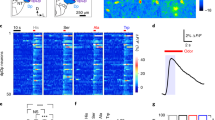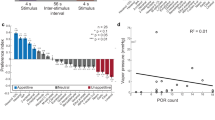Abstract
Hedonic value is a dominant aspect of olfactory perception. Using optogenetic manipulation in freely behaving mice paired with immediate early gene mapping, we demonstrate that hedonic information is represented along the antero-posterior axis of the ventral olfactory bulb. Using this representation, we show that the degree of attractiveness of odors can be bidirectionally modulated by local manipulation of the olfactory bulb's neural networks in freely behaving mice.
This is a preview of subscription content, access via your institution
Access options
Subscribe to this journal
Receive 12 print issues and online access
$209.00 per year
only $17.42 per issue
Buy this article
- Purchase on Springer Link
- Instant access to full article PDF
Prices may be subject to local taxes which are calculated during checkout



Similar content being viewed by others
References
Richardson, J.T. & Zucco, G.M. Psychol. Bull. 105, 352–360 (1989).
Yeshurun, Y. & Sobel, N. Annu. Rev. Psychol. 61, 219–241 (2010).
Barkat, S., Poncelet, J., Landis, B.N., Rouby, C. & Bensafi, M. Neurosci. Lett. 434, 108–112 (2008).
Yeomans, M.R., Mobini, S., Elliman, T.D., Walker, H.C. & Stevenson, R.J. J. Exp. Psychol. Anim. Behav. Process. 32, 215–228 (2006).
Mandairon, N., Poncelet, J., Bensafi, M. & Didier, A. PLoS One 4, e4209 (2009).
Mori, K. & Sakano, H. Annu. Rev. Neurosci. 34, 467–499 (2011).
Kobayakawa, K. et al. Nature 450, 503–508 (2007).
Takahashi, Y.K., Nagayama, S. & Mori, K. J. Neurosci. 24, 8690–8694 (2004).
Johnson, M.A. et al. Proc. Natl. Acad. Sci. USA 109, 13410–13415 (2012).
Mandairon, N. et al. J. Neurosci. Methods 180, 296–303 (2009).
Nagayama, S., Homma, R. & Imamura, F. Front. Neural Circuits 8, 98 (2014).
Inaki, K., Takahashi, Y.K., Nagayama, S. & Mori, K. Eur. J. Neurosci. 15, 1563–1574 (2002).
Mandairon, N., Didier, A. & Linster, C. Neurobiol. Learn. Mem. 90, 178–184 (2008).
Moreno, M.M. et al. J. Neurosci. 32, 3748–3758 (2012).
Mandairon, N. et al. Eur. J. Neurosci. 24, 3578–3588 (2006).
Lapid, H. et al. Nat. Neurosci. 14, 1455–1461 (2011).
Imamura, F., Ayoub, A.E., Rakic, P. & Greer, C.A. Nat. Neurosci. 14, 331–337 (2011).
Gadziola, M.A., Tylicki, K.A., Christian, D.L. & Wesson, D.W. J. Neurosci. 35, 4515–4527 (2015).
Li, Q. & Liberles, S.D. Curr. Biol. 25, R120–R129 (2015).
Cleland, T.A., Morse, A., Yue, E.L. & Linster, C. Behav. Neurosci. 116, 222–231 (2002).
Mandairon, N., Sultan, S., Nouvian, M., Sacquet, J. & Didier, A. J. Neurosci. 31, 12455–12460 (2011).
Busto, G.U. et al. Eur. J. Neurosci. 29, 1431–1439 (2009).
Gradinaru, V. et al. Cell 141, 154–165 (2010).
Moreno, M.M. et al. Proc. Natl. Acad. Sci. USA 106, 17980–17985 (2009).
Sultan, S., Rey, N., Sacquet, J., Mandairon, N. & Didier, A. J. Neurosci. 31, 14893–14898 (2011).
Acknowledgements
We thank G. Froment, D. Nègre and C. Costa from the lentivector production facility at SFR BioSciences de Lyon (UMS3444/US8); A. Fleischmann and I. Vieira for their help with the optogenetic set up; P. Fonlupt for his help with the statistical analysis; Y. Yoshihara (Riken Brain Science Institute, Saitama, Japan) for the gift of the Tbx21 antibody and C. Linster, M. Bensafi and A. Fournel for their helpful comments on the manuscript. This work was supported by the CNRS, INSERM, Lyon 1 University, the Roudnitska Foundation (fellowship to M.M.) and the French Ministry for Research and Ecole Normale Supérieure de Lyon (fellowship to F.K.).
Author information
Authors and Affiliations
Contributions
F.K., A.D. and N.M. conceived the experiments; F.K., M.M., N.K., J.F., J.S. and N.M. performed the experiments; C.B. and M.R. engineered the lentiviruses; F.K., M.M., M.T., A.D., M.T., N.K. and N.M. analyzed the data and F.K., M.M., M.R., A.D. and N.M. wrote the article.
Corresponding author
Ethics declarations
Competing interests
The authors declare no competing financial interests.
Integrated supplementary information
Supplementary Figure 1 Molecular structures of the 16 odorants used in the behavioral study.
Geraniol (Ger); Dodecanal (Dod); Citronellol (Citro); 3-Hexanol (Hex); Thioglycolic acid (ThioA); Pyridine (Pyr); Ethyl butyrate (EtB); Benzyl acetate (BenA); Guaiacol (Guai); Camphor (Cam); p-Cresol (Cres); Cineole (Cine); D-Limonene (Lim); D-Carvone (Carv); β-Ionone (Ion); β-Caryophyllene (Caryo). Two-dimensional drawings were obtained from Pubchem: http://pubchem.ncbi.nlm.nih.gov/.
Supplementary Figure 2 Attractiveness of odorants: comparison with urine and TMT.
(a) Mice investigation time varies for the different odorants (odor effect F(11,319)=7.29, permutation test p<0.0001 and Wilcoxon tests, #: differences from TMT: urine 0.00001; Cine 0.0001; Ion 0.0001; Cam 0.003; Citro 0.001; Lim 0.005; Guai 0.02; Thio 0.016 and *: differences from urine: TMT 0.0001; Hex 0.0002; Cres 0.0001; Pyr 0.001; Thio 0.0004; Guai 0.0009; Lim 0.009; Citro 0.04; n=30). Five experimental points above 30 s are not shown (Lim 1; Citro 2; Cam 2). (b) Mice speed of approach to the odor source varies depending on the odorant (odor effect F(11,154)=10.43, permutation test p<0.0001 and Wilcoxon test. #: differences from TMT: urine 0.0009; Cine 0.0009; Cam 0.015; Citro 0.002. *: differences from urine: TMT 0.0009; Guai 0.0006; Pyr 0.0009; Thio 0.0009; Hex 0.0006; Cres 0.0009; Lim 0.007; Ion 0.006) (n=15; mean±sem). (c) Pearson correlation R=0.82, p=0.00. Citronellol (Citro); 3-Hexanol (Hex); Thioglycolic acid (Thio); Pyridine (Pyr); Guaiacol (Guai); Camphor (Cam); p-Cresol (Cres); Cineole (Cine); D-Limonene (Lim); β-Ionone (Ion).
Supplementary Figure 3 Profile view of patterns evoked by pleasant and unpleasant odorants.
(a) Profile views of both granule and glomerular cell layers were obtained by averaging the values of the medial and lateral sectors projected into a lateral view of the OB. In addition, the representation reflects the size of the sections. (b). Left, maps depicting the distribution of Zif268-positive cell density in the glomerular layer in response to high or low attractiveness odorants. Middle, point-to point substraction maps. Right, point-to point map comparisons by Mann Whitney U tests to which FDR correction was applied. Significance was set at p<0.05. (c). Same as b for the granule cell layer. (d). Overlap maps of the glomerular layer reflecting the activation hotspots for high and low attractive odorants. Overlap maps were obtained by summing averaged odor maps (n = 2 to 5 animals per odor) that were thresholded to keep the 20% bins with the highest Zif268 density and binarized so that bins within the 20% highest density were given a value = 1 and all the other bins were given a value of 0. This was done for high (left) and low (middle) attractiveness odorants. To reveal hotspots specific to low and high attractiveness odorants, the overlap map for high attractive odorant was subtracted from the overlap map for low attractive odorant (right). In this map, negative values (blue) indicate bins selectively activated by highly attractive odorants and positive values (red) indicate bins selectively activated by low attractive odorants. (e). Same as d for the granule cell layer.
Supplementary Figure 4 Distribution of Zif+ labeling: comparison between artificial and experimental groups.
An antero-posterior index was calculated from the Mann-Whitney U tests maps (FDR corrected) as the % of bins with p value<0.05 in anterior region (-) % of bins with p value < 0.05 in posterior region, for each layer in artificial and experimental groups. Artificial groups are composed of 5% high and 50% low attractiveness odorants randomly selected.
Supplementary Figure 5 Overlaps maps.
(a) Overlap maps of the glomerular layer obtained by summing averaged odor maps threshold and binarized so that bins within the 20% highest density were given a value=1 and all the other bins were given a value of 0. This was done for high (left) and low (middle) attractiveness odorants. Overlap map for low attractiveness odorants was subtracted from the overlap map for highly attractive odorants (right). Negative values (blue) indicate bins selectively activated by highly attractiveness odorants and positive values (red) indicate bins selectively activated by low attractiveness odorants. (b) Same as a for the granule cell layer. AOB: accessory olfactory bulb.
Supplementary Figure 6 Optogenetic experiments: cellular assessment of virus transfection and of effect of light stimulation.
(a) EYFP+ area at the viral injection site in NpRH mice; placement of the optical fiber tip above the ventral OB is shown (left); same OB at distance of the injection site (middle). High magnification of EYFP-positive neurons in the vicinity of the virus injection site (right). Representative of 31 animals (b) Density of EYFP+ neurons is higher in the areas targeted by the viral infusion than in non-targeted ones (left, ventro-posterior infusion n = 15 p = 0.0014 and right, ventro-anterior infusion n = 16 p = 0.0007). Control empty virus and NpHR virus injected mice were pooled. (c). Light stimulation decreased the percentage of EYFP+ cells expressing Zif268 in light-targeted areas of NpHR mice, ventro-posterior OB (left, n=15, *:p=0.011) or anterior OB (right, n=16, *:p=0.017) compared to the light non-targeted regions. This difference was not observed in mice infused with the control virus. (d) This difference was retrieved when considering the density of total Zif268+ cells (left, n=15, *:p=0.01 for ventro-posterior and right, n=16, *:p=0.017 for anterior injections) (mean±sem).
Supplementary Figure 7 Assessment of viral transfection in the dorsal OB.
(a) The percentage of YFP/Zif268+ cells in the dorsal granule cell layer was not modulated in NpRH mice (n=4) compared to controls (n=4) (Mann-Whitney p=0.66; (mean±sem). (b). Representative image of YFP/Zif268-positive cell labeling. Representative of 8 animals. Arrow indicates double labeled cells. Scale bar, 5 µm.
Supplementary Figure 8 Optogenetic inhibition of granule cells impact mitral cell firing.
(a) Light stimulation (yellow bars) on OB slices prevented firing of a granule cell expressing NpHR by producing a membrane potential hyperpolarization and blocked the firing generated by a step of current injection. The same stimulation was ineffective on granule cells expressing the control virus. (b) The percentage of mitral cells (Tbx21) expressing Zif268 is higher in ventral compared to dorsal OB of NpRH mice (Wilcoxon, p=0.027; n=6) (mean±sem). This is not retrieved in control mice (Wilcoxon, p=0.24; n=6). (c) Representative image of Tbx21/Zif268 labeling (representative of 12 animals). Scale bar, 10 µm.
Supplementary Figure 9 The investigation time for unpleasant and pleasant odorants upon light stimulation in NpHR and control mice.
(a) Postero-ventral light-triggered inhibition increased investigation time in NpHR (blue) vs control (grey) mice (Mann-Whitney on groups, p<0.0001) for unpleasant odorants but (c) not for pleasant odorants (p=0.75). (b) Antero-ventral light-triggered inhibition decreased investigation time in NpHR versus control mice for pleasant (p<0.0001) and (d) unpleasant (p=0.001) odorants. In all experiments, the light stimulation had no effect in the no odor condition (p>0.05). n=5 for controls and n=5 for NpHR (mean±sem).Citronellol (Citro); 3-Hexanol (Hex); Thioglycolic acid (TA); Pyridine (Pyr); Guaiacol (GA); Camphor (Cam); p-Cresol (Cres); Cineole (Cine); D-Limonene (Lim); β-Ionone (Ion); no odorant (NO).
Supplementary information
Supplementary Text and Figures
Supplementary Figures 1–8 and Supplementary Tables 1–3 (PDF 1284 kb)
Rights and permissions
About this article
Cite this article
Kermen, F., Midroit, M., Kuczewski, N. et al. Topographical representation of odor hedonics in the olfactory bulb. Nat Neurosci 19, 876–878 (2016). https://doi.org/10.1038/nn.4317
Received:
Accepted:
Published:
Issue Date:
DOI: https://doi.org/10.1038/nn.4317
This article is cited by
-
Neural manifolds for odor-driven innate and acquired appetitive preferences
Nature Communications (2023)
-
Odor hedonics coding in the vertebrate olfactory bulb
Cell and Tissue Research (2021)
-
Stimulus-specific behavioral responses of zebrafish to a large range of odors exhibit individual variability
BMC Biology (2020)
-
Target specific functions of EPL interneurons in olfactory circuits
Nature Communications (2019)
-
Short-term availability of adult-born neurons for memory encoding
Nature Communications (2019)



